Tribological, Corrosion, and Microstructural Features of Laser-Shock-Peened Steels
Abstract
1. Introduction
2. Mechanism of Laser Shock Peening
3. Microstructural Evolution of LSPed Steels
3.1. Effect of LSP on Plain Carbon Steels
3.2. Effect of LSP on Alloy Steels
4. Tribological Properties of LSPed Steels
5. Corrosion Properties
6. Recent Advances
7. Applications
8. Conclusions
Author Contributions
Funding
Institutional Review Board Statement
Informed Consent Statement
Data Availability Statement
Acknowledgments
Conflicts of Interest
Abbreviations
| COF | Coefficient of friction |
| GNS | Gradient nanostructured surface |
| LSP | Laser shock peening |
| LSSP | Laser shock surface patterning |
| RCS | Residual compressive ftress |
| SP | Shot peening |
| SPD | Severe plastic deformation |
| SSP | Severe shot peening |
| SS | Stainless steel |
| SEM | Scanning electron microscope |
| SMAT | Surface mechanical attrition treatment |
| SFE | Stacking fault energy |
| TEM | Transmission electron microscopy |
| USP | Ultrasonic shot peening |
| UIP | Ultrasonic impact peening |
| USRP | Ultrasonic surface rolling process |
| UNSM | Ultrasonic nanocrystal surface modification |
References
- Ralls, A.M.; Daroonparvar, M.; Sikdar, S.; Rahman, M.H.; Monwar, M.; Watson, K.; Kay, C.M.; Menezes, P.L. Tribological and Corrosion Behavior of High Pressure Cold Sprayed Duplex 316 L Stainless Steel. Tribol. Int. 2022, 169, 107471. [Google Scholar] [CrossRef]
- Bloyce, A.; Qi, P.-Y.; Dong, H.; Bell, T. Surface Modification of Titanium Alloys for Combined Improvements in Corrosion and Wear Resistance. Surf. Coat. Technol. 1998, 107, 125–132. [Google Scholar] [CrossRef]
- Ralls, A.M.; John, M.; Noud, J.; Lopez, J.; LeSourd, K.; Napier, I.; Hallas, N.; Menezes, P.L. Tribological, Corrosion, and Mechanical Properties of Selective Laser Melted Steel. Metals 2022, 12, 1732. [Google Scholar] [CrossRef]
- Bhat, K.U.; Panemangalore, D.B.; Kuruveri, S.B.; John, M.; Menezes, P.L. Surface Modification of 6xxx Series Aluminum Alloys. Coatings 2022, 12, 180. [Google Scholar] [CrossRef]
- John, M.; Kalvala, P.R.; Misra, M.; Menezes, P.L. Peening Techniques for Surface Modification: Processes, Properties, and Applications. Materials 2021, 14, 3841. [Google Scholar] [CrossRef]
- Liu, H.; Jiang, C.; Chen, M.; Wang, L.; Ji, V. Surface Layer Microstructures and Wear Properties Modifications of Mg-8Gd-3Y Alloy Treated by Shot Peening. Mater. Charact. 2019, 158, 109952. [Google Scholar] [CrossRef]
- Malaki, M.; Ding, H. A Review of Ultrasonic Peening Treatment. Mater. Des. 2015, 87, 1072–1086. [Google Scholar] [CrossRef]
- Li, L.; Kim, M.; Lee, S.; Bae, M.; Lee, D. Influence of Multiple Ultrasonic Impact Treatments on Surface Roughness and Wear Performance of SUS301 Steel. Surf. Coat. Technol. 2016, 307, 517–524. [Google Scholar] [CrossRef]
- Mao, B.; Siddaiah, A.; Liao, Y.; Menezes, P.L. Laser Surface Texturing and Related Techniques for Enhancing Tribological Performance of Engineering Materials: A Review. J. Manuf. Process. 2020, 53, 153–173. [Google Scholar] [CrossRef]
- Tong, Z.P.; Ren, X.D.; Zhou, W.F.; Adu-Gyamfi, S.; Chen, L.; Ye, Y.X.; Ren, Y.P.; Dai, F.Z.; Yang, J.D.; Li, L. Effect of Laser Shock Peening on Wear Behaviors of TC11 Alloy at Elevated Temperature. Opt. Laser Technol. 2019, 109, 139–148. [Google Scholar] [CrossRef]
- John, M.; Kuruveri, U.B.; Menezes, P.L. Laser Cladding-Based Surface Modification of Carbon Steel and High-Alloy Steel for Extreme Condition Applications. Coatings 2022, 12, 1444. [Google Scholar] [CrossRef]
- John, M.; Ralls, A.M.; Dooley, S.C.; Thazhathidathil, A.K.V.; Perka, A.K.; Kuruveri, U.B.; Menezes, P.L. Ultrasonic Surface Rolling Process: Properties, Characterization, and Applications. Appl. Sci. 2021, 11, 10986. [Google Scholar] [CrossRef]
- Yin, M.; Cai, Z.; Zhang, Z.; Yue, W. Effect of Ultrasonic Surface Rolling Process on Impact-Sliding Wear Behavior of the 690 Alloy. Tribol. Int. 2020, 147, 105600. [Google Scholar] [CrossRef]
- Maleki, E.; Bagherifard, S.; Unal, O.; Bandini, M.; Farrahi, G.H.; Guagliano, M. Introducing Gradient Severe Shot Peening as a Novel Mechanical Surface Treatment. Sci. Rep. 2021, 11, 22035. [Google Scholar] [CrossRef]
- Peral, L.B.; Quintero, A.; Vielma, A.T.; Barbés, M.F.; Fernández-Pariente, I. TEM Evaluation of Steel Nanocrystalline Surfaces Obtained by Severe Shot Peening. Surf. Coat. Technol. 2021, 418, 127238. [Google Scholar] [CrossRef]
- Kumar, N.; Chaudhari, G.P.; Meka, S.R. Influence of Ultrasonic Shot Peening on Microstructure, Mechanical, and Electrochemical Behavior of 316 Stainless Steel. J. Mater. Eng. Perform. 2021, 31, 2364–2380. [Google Scholar] [CrossRef]
- Kumar, P.; Mahobia, G.S.; Mandal, S.; Singh, V.; Chattopadhyay, K. Enhanced Corrosion Resistance of the Surface Modified Ti-13Nb-13Zr Alloy by Ultrasonic Shot Peening. Corros. Sci. 2021, 189, 109597. [Google Scholar] [CrossRef]
- Liu, R.; Yuan, S.; Lin, N.; Zeng, Q.; Wang, Z.; Wu, Y. Application of Ultrasonic Nanocrystal Surface Modification (UNSM) Technique for Surface Strengthening of Titanium and Titanium Alloys: A Mini Review. J. Mater. Res. Technol. 2021, 11, 351–377. [Google Scholar] [CrossRef]
- Zou, Y.; Li, J.; Liu, X.; He, T.; Lu, J.; Li, D.; Li, Y. Effect of Multiple Ultrasonic Nanocrystal Surface Modification on Surface Integrity and Wear Property of DZ2 Axle Steel. Surf. Coat. Technol. 2021, 412, 127012. [Google Scholar] [CrossRef]
- Kishore, A.; John, M.; Ralls, A.M.; Jose, S.A.; Kuruveri, U.B.; Menezes, P.L. Ultrasonic Nanocrystal Surface Modification: Processes, Characterization, Properties, and Applications. Nanomaterials 2022, 12, 1415. [Google Scholar] [CrossRef]
- Ralls, A.M.; Kasar, A.K.; Menezes, P.L. Friction Stir Processing on the Tribological, Corrosion, and Erosion Properties of Steel: A Review. J. Manuf. Mater. Process. 2021, 5, 97. [Google Scholar] [CrossRef]
- Sun, Y. Sliding Wear Behaviour of Surface Mechanical Attrition Treated AISI 304 Stainless Steel. Tribol. Int. 2013, 57, 67–75. [Google Scholar] [CrossRef]
- Liu, Y.; Jin, B.; Li, D.-J.; Zeng, X.-Q.; Lu, J. Wear Behavior of Nanocrystalline Structured Magnesium Alloy Induced by Surface Mechanical Attrition Treatment. Surf. Coat. Technol. 2015, 261, 219–226. [Google Scholar] [CrossRef]
- Lei, L.; Zhao, Q.; Zhao, Y.; Wu, C.; Huang, S.; Jia, W.; Zeng, W. Gradient Nanostructure, Phase Transformation, Amorphization and Enhanced Strength-Plasticity Synergy of Pure Titanium Manufactured by Ultrasonic Surface Rolling. J. Mater. Process. Technol. 2022, 299, 117322. [Google Scholar] [CrossRef]
- Chen, M.; Xing, S.; Li, J.; He, J.; Lu, Y.; Jiang, C.; Ji, V. Surface Residual Stress and Microstructure Evolutions of Hastelloy X Alloy after Severe Shot Peening. Vacuum 2021, 187, 110136. [Google Scholar] [CrossRef]
- Sun, Q.; Han, Q.; Wang, S.; Xu, R. Microstructure, Corrosion Behaviour and Thermal Stability of AA 7150 after Ultrasonic Shot Peening. Surf. Coat. Technol. 2020, 398, 126127. [Google Scholar] [CrossRef]
- Listyawan, T.A.; Lee, H.; Park, N.; Lee, U. Microstructure and Mechanical Properties of CoCrFeMnNi High Entropy Alloy with Ultrasonic Nanocrystal Surface Modification Process. J. Mater. Sci. Technol. 2020, 57, 123–130. [Google Scholar] [CrossRef]
- Wang, Z.D.; Sun, G.F.; Lu, Y.; Chen, M.Z.; Bi, K.D.; Ni, Z.H. Microstructural Characterization and Mechanical Behavior of Ultrasonic Impact Peened and Laser Shock Peened AISI 316L Stainless Steel. Surf. Coat. Technol. 2020, 385, 125403. [Google Scholar] [CrossRef]
- Zhang, C.; Dong, Y.; Ye, C. Recent Developments and Novel Applications of Laser Shock Peening: A Review. Adv. Eng. Mater. 2021, 23, 2001216. [Google Scholar] [CrossRef]
- Zhao, J.; Pan, X.; Li, J.; Huang, Z.; Kan, Q.; Kang, G.; Zhou, L.; Zhang, X. Laser Shock Peened Ti-6Al-4 V Alloy: Experiments and Modeling. Int. J. Mech. Sci. 2022, 213, 106874. [Google Scholar] [CrossRef]
- Song, J.; Luo, S.; Liang, X.; Cao, Z.; Zhao, W.; Pu, C.; He, W. Rolling Contact Fatigue and Damage Characteristic of AISI 9310 Steel with Pre-Laser Shock Peening Treatment. Int. J. Fatigue 2022, 155, 106588. [Google Scholar] [CrossRef]
- Zhang, H.; Cai, Z.; Chi, J.; Han, G.; Sun, R.; Che, Z.; Zhang, H.; Guo, W. Microstructural Evolution, Mechanical Behaviors and Strengthening Mechanism of 300 M Steel Subjected to Multi-Pass Laser Shock Peening. Opt. Laser Technol. 2022, 148, 107726. [Google Scholar] [CrossRef]
- Lim, H.; Kim, P.; Jeong, H.; Jeong, S. Enhancement of Abrasion and Corrosion Resistance of Duplex Stainless Steel by Laser Shock Peening. J. Mater. Process. Technol. 2012, 212, 1347–1354. [Google Scholar] [CrossRef]
- Ye, C.; Suslov, S.; Lin, D.; Cheng, G.J. Deformation-Induced Martensite and Nanotwins by Cryogenic Laser Shock Peening of AISI 304 Stainless Steel and the Effects on Mechanical Properties. Philos. Mag. 2012, 92, 1369–1389. [Google Scholar] [CrossRef]
- Li, J.; Zhou, J.; Liu, L.; Feng, A.; Huang, S.; Meng, X. High-Cycle Bending Fatigue Behavior of TC6 Titanium Alloy Subjected to Laser Shock Peening Assisted by Cryogenic Temperature. Surf. Coat. Technol. 2021, 409, 126848. [Google Scholar] [CrossRef]
- Liao, Y.; Ye, C.; Cheng, G.J. [INVITED] A Review: Warm Laser Shock Peening and Related Laser Processing Technique. Opt. Laser Technol. 2016, 78, 15–24. [Google Scholar] [CrossRef]
- Ye, C.; Suslov, S.; Kim, B.J.; Stach, E.A.; Cheng, G.J. Fatigue Performance Improvement in AISI 4140 Steel by Dynamic Strain Aging and Dynamic Precipitation during Warm Laser Shock Peening. Acta Mater. 2011, 59, 1014–1025. [Google Scholar] [CrossRef]
- Prabhakaran, S.; Kalainathan, S. Warm Laser Shock Peening without Coating Induced Phase Transformations and Pinning Effect on Fatigue Life of Low-Alloy Steel. Mater. Des. 2016, 107, 98–107. [Google Scholar] [CrossRef]
- Mao, B.; Siddaiah, A.; Menezes, P.L.; Liao, Y. Surface Texturing by Indirect Laser Shock Surface Patterning for Manipulated Friction Coefficient. J. Mater. Process. Technol. 2018, 257, 227–233. [Google Scholar] [CrossRef]
- Zhang, X.; Mao, B.; Siddaiah, A.; Menezes, P.L.; Liao, Y. Direct Laser Shock Surface Patterning of an AZ31B Magnesium Alloy: Microstructure Evolution and Friction Performance. J. Mater. Process. Technol. 2020, 275, 116333. [Google Scholar] [CrossRef]
- Choi, D.C.; Kim, H.S. Performance Evaluation of Laser Shock Micro-Patterning Process on Aluminum Surface with Various Process Parameters and Loading Schemes. Opt. Lasers Eng. 2020, 124, 105799. [Google Scholar] [CrossRef]
- Etsion, I. Improving Tribological Performance of Mechanical Components by Laser Surface Texturing. Tribol. Lett. 2004, 17, 733–737. [Google Scholar] [CrossRef]
- Borghi, A.; Gualtieri, E.; Marchetto, D.; Moretti, L.; Valeri, S. Tribological Effects of Surface Texturing on Nitriding Steel for High-Performance Engine Applications. Wear 2008, 265, 1046–1051. [Google Scholar] [CrossRef]
- Xu, P.; Lin, C.; Zhou, C.; Yi, X. Wear and Corrosion Resistance of Laser Cladding AISI 304 Stainless Steel/Al2O3 Composite Coatings. Surf. Coat. Technol. 2014, 238, 9–14. [Google Scholar] [CrossRef]
- Weng, F.; Chen, C.; Yu, H. Research Status of Laser Cladding on Titanium and Its Alloys: A Review. Mater. Des. 2014, 58, 412–425. [Google Scholar] [CrossRef]
- Zhu, L.; Xue, P.; Lan, Q.; Meng, G.; Ren, Y.; Yang, Z.; Xu, P.; Liu, Z. Recent Research and Development Status of Laser Cladding: A Review. Opt. Laser Technol. 2021, 138, 106915. [Google Scholar] [CrossRef]
- Gao, Y.K. Improvement of Fatigue Property in 7050–T7451 Aluminum Alloy by Laser Peening and Shot Peening. Mater. Sci. Eng. A 2011, 528, 3823–3828. [Google Scholar] [CrossRef]
- Hongchao, Q. Experimental Investigation of Laser Peening on Ti17 Titanium Alloy for Rotor Blade Applications. Appl. Surf. Sci. 2015, 351, 524–530. [Google Scholar] [CrossRef]
- Qin, Z.; Li, B.; Huang, X.; Zhang, H.; Chen, R.; Adeel, M.; Xue, H. The Effect of Laser Shock Peening on Surface Integrity and High and Very High Cycle Fatigue Properties of 2024-T351 Aluminum Alloy. Opt. Laser Technol. 2022, 149, 107897. [Google Scholar] [CrossRef]
- Ganesh, P.; Sundar, R.; Kumar, H.; Kaul, R.; Ranganathan, K.; Hedaoo, P.; Tiwari, P.; Kukreja, L.M.; Oak, S.M.; Dasari, S.; et al. Studies on Laser Peening of Spring Steel for Automotive Applications. Opt. Lasers Eng. 2012, 50, 678–686. [Google Scholar] [CrossRef]
- Ebrahimi, M.; Amini, S.; Mahdavi, S.M. The Investigation of Laser Shock Peening Effects on Corrosion and Hardness Properties of ANSI 316L Stainless Steel. Int. J. Adv. Manuf. Technol. 2017, 88, 1557–1565. [Google Scholar] [CrossRef]
- Abeens, M.; Muruganandhan, R.; Thirumavalavan, K. Effect of Low Energy Laser Shock Peening on Plastic Deformation, Wettability and Corrosion Resistance of Aluminum Alloy 7075 T651. Optik 2020, 219, 165045. [Google Scholar] [CrossRef]
- Gupta, R.K.; Sunil Kumar, B.; Sundar, R.; Ram Sankar, P.; Ganesh, P.; Kaul, R.; Kain, V.; Ranganathan, K.; Bindra, K.S.; Singh, B. Enhancement of Intergranular Corrosion Resistance of Type 304 Stainless Steel through Laser Shock Peening. Corros. Eng. Sci. Technol. 2017, 52, 220–225. [Google Scholar] [CrossRef]
- Wang, F.; Yao, Z.; Deng, Q. Experimental Study on Laser Shock Processing of Brass. J. Univ. Sci. Technol. Beijing Miner. Metall. Mater. 2007, 14, 529–532. [Google Scholar] [CrossRef]
- Luo, K.Y.; Lu, J.Z.; Zhang, Y.K.; Zhou, J.Z.; Zhang, L.F.; Dai, F.Z.; Zhang, L.; Zhong, J.W.; Cui, C.Y. Effects of Laser Shock Processing on Mechanical Properties and Micro-Structure of ANSI 304 Austenitic Stainless Steel. Mater. Sci. Eng. A 2011, 528, 4783–4788. [Google Scholar] [CrossRef]
- Zhang, R.; Zhou, X.; Gao, H.; Mankoci, S.; Liu, Y.; Sang, X.; Qin, H.; Hou, X.; Ren, Z.; Doll, G.L.; et al. The Effects of Laser Shock Peening on the Mechanical Properties and Biomedical Behavior of AZ31B Magnesium Alloy. Surf. Coat. Technol. 2018, 339, 48–56. [Google Scholar] [CrossRef]
- Sundar, R.; Ganesh, P.; Gupta, R.K.; Ragvendra, G.; Pant, B.K.; Kain, V.; Ranganathan, K.; Kaul, R.; Bindra, K.S. Laser Shock Peening and Its Applications: A Review. Lasers Manuf. Mater. Process. 2019, 6, 424–463. [Google Scholar] [CrossRef]
- Hatamleh, O. A Comprehensive Investigation on the Effects of Laser and Shot Peening on Fatigue Crack Growth in Friction Stir Welded AA 2195 Joints. Int. J. Fatigue 2009, 31, 974–988. [Google Scholar] [CrossRef]
- Montross, C.S.; Florea, V.; Swain, M.V. The Influence of Coatings on Subsurface Mechanical Properties of Laser Peened 2011-T3 Aluminum. J. Mater. Sci. 2001, 36, 1801–1807. [Google Scholar] [CrossRef]
- Hong, X.; Wang, S.; Guo, D.; Wu, H.; Wang, J.; Dai, Y.; Xia, X.; Xie, Y. Confining Medium and Absorptive Overlay: Their Effects on a Laser-Induced Shock Wave. Opt. Lasers Eng. 1998, 29, 447–455. [Google Scholar] [CrossRef]
- Zhou, Z.; Bhamare, S.; Ramakrishnan, G.; Mannava, S.R.; Langer, K.; Wen, Y.; Qian, D.; Vasudevan, V.K. Thermal Relaxation of Residual Stress in Laser Shock Peened Ti–6Al–4V Alloy. Surf. Coat. Technol. 2012, 206, 4619–4627. [Google Scholar] [CrossRef]
- Takata, T.; Enoki, M.; Chivavibul, P.; Matsui, A.; Kobayashi, Y. Effect of Confinement Layer on Laser Ablation and Cavitation Bubble during Laser Shock Peening. Mater. Trans. 2016, 57, 1776–1783. [Google Scholar] [CrossRef]
- Peyre, P.; Fabbro, R. Laser Shock Processing: A Review of the Physics and Applications. Opt. Quantum Electron. 1995, 27, 1213–1229. [Google Scholar] [CrossRef]
- Clauer, A.H.; Fairand, B.P. Interaction of Laser-Induced Stress Waves with Metals. In Proceedings of the ASM Conference Applications of Lasers in Materials Processing, Washington, DC, USA, February 1979; Available online: https://www.researchgate.net/publication/4687662_Interaction_of_laser-induced_stress_waves_with_metals (accessed on 1 February 2023).
- Yakimets, I.; Richard, C.; Béranger, G.; Peyre, P. Laser Peening Processing Effect on Mechanical and Tribological Properties of Rolling Steel 100Cr6. Wear 2004, 256, 311–320. [Google Scholar] [CrossRef]
- Zhang, R.; Hou, X.; Zhou, X.; Gao, H.; Mankoci, S.; Qin, H.; Ren, Z.; Doll, G.L.; Martini, A.; Dong, Y.; et al. Effects of Laser Shock Peening on the Wear and Degradation Behaviors of Magnesium Alloys. In Proceedings of the 11th International Manufacturing Science and Engineering Conference, Blacksburg, VA, USA, 27 June–1 July 2016. [Google Scholar]
- Peyre, P.; Fabbro, R.; Merrien, P.; Lieurade, H.P. Laser Shock Processing of Aluminium Alloys. Application to High Cycle Fatigue Behaviour. Mater. Sci. Eng. A 1996, 210, 102–113. [Google Scholar] [CrossRef]
- Devaux, D.; Fabbro, R.; Tollier, L.; Bartnicki, E. Generation of Shock Waves by Laser-induced Plasma in Confined Geometry. J. Appl. Phys. 1993, 74, 2268–2273. [Google Scholar] [CrossRef]
- Fabbro, R.; Fournier, J.; Ballard, P.; Devaux, D.; Virmont, J. Physical Study of Laser-produced Plasma in Confined Geometry. J. Appl. Phys. 1990, 68, 775–784. [Google Scholar] [CrossRef]
- Johnson, J.N.; Rohde, R.W. Dynamic Deformation Twinning in Shock-Loaded Iron. J. Appl. Phys. 1971, 42, 4171–4182. [Google Scholar] [CrossRef]
- Ballard, P.; Fournier, J.; Fabbro, R.; Frelat, J. Residual stresses induced by laser-shocks. J. Phys. IV Fr. 1991, 01, C3-487–C3-494. [Google Scholar] [CrossRef]
- Montross, C.S.; Wei, T.; Ye, L.; Clark, G.; Mai, Y.-W. Laser Shock Processing and Its Effects on Microstructure and Properties of Metal Alloys: A Review. Int. J. Fatigue 2002, 24, 1021–1036. [Google Scholar] [CrossRef]
- Siddaiah, A.; Mao, B.; Liao, Y.; Menezes, P.L. Surface Characterization and Tribological Performance of Laser Shock Peened Steel Surfaces. Surf. Coat. Technol. 2018, 351, 188–197. [Google Scholar] [CrossRef]
- Lu, H.F.; Xue, K.N.; Xu, X.; Luo, K.Y.; Xing, F.; Yao, J.H.; Lu, J.Z. Effects of Laser Shock Peening on Microstructural Evolution and Wear Property of Laser Hybrid Remanufactured Ni25/Fe104 Coating on H13 Tool Steel. J. Mater. Process. Technol. 2021, 291, 117016. [Google Scholar] [CrossRef]
- Shadangi, Y.; Chattopadhyay, K.; Rai, S.B.; Singh, V. Effect of LASER Shock Peening on Microstructure, Mechanical Properties and Corrosion Behavior of Interstitial Free Steel. Surf. Coat. Technol. 2015, 280, 216–224. [Google Scholar] [CrossRef]
- Chu, J.P.; Rigsbee, J.M.; Banas, G.; Elsayed-Ali, H.E. Laser-Shock Processing Effects on Surface Microstructure and Mechanical Properties of Low Carbon Steel. Mater. Sci. Eng. A Struct. Mater. Prop. Microstruct. Process. 1999, 260, 260–268. [Google Scholar] [CrossRef]
- Hu, Y.; Yao, Z. Overlapping Rate Effect on Laser Shock Processing of 1045 Steel by Small Spots with Nd:YAG Pulsed Laser. Surf. Coat. Technol. 2008, 202, 1517–1525. [Google Scholar] [CrossRef]
- Peyre, P.; Berthe, L.; Scherpereel, X.; Fabbro, R. Laser-Shock Processing of Aluminium-Coated 55C1 Steel in Water-Confinement Regime, Characterization and Application to High-Cycle Fatigue Behaviour. J. Mater. Sci. 1998, 33, 1421–1429. [Google Scholar]
- Xiong, Y.; He, T.; Guo, Z.; He, H.; Ren, F.; Volinsky, A.A. Effects of Laser Shock Processing on Surface Microstructure and Mechanical Properties of Ultrafine-Grained High Carbon Steel. Mater. Sci. Eng. A 2013, 570, 82–86. [Google Scholar] [CrossRef]
- Ren, Y.; Wan, H.; Chen, Y.; Zhu, H.; Lu, H.; Ren, X. Effect of Laser Shock Peening and Carbonitriding on Tribological Properties of 20Cr2Mn2Mo Steel Alloy under Dry Sliding Conditions. Surf. Coat. Technol. 2021, 417, 127215. [Google Scholar] [CrossRef]
- Rai, A.K.; Biswal, R.; Gupta, R.K.; Singh, R.; Rai, S.K.; Ranganathan, K.; Ganesh, P.; Kaul, R.; Bindra, K.S. Study on the Effect of Multiple Laser Shock Peening on Residual Stress and Microstructural Changes in Modified 9Cr-1Mo (P91) Steel. Surf. Coat. Technol. 2019, 358, 125–135. [Google Scholar] [CrossRef]
- Rai, A.K.; Biswal, R.; Gupta, R.K.; Rai, S.K.; Singh, R.; Goutam, U.K.; Ranganathan, K.; Ganesh, P.; Kaul, R.; Bindra, K.S. Enhancement of Oxidation Resistance of Modified P91 Grade Ferritic-Martensitic Steel by Surface Modification Using Laser Shock Peening. Appl. Surf. Sci. 2019, 495, 143611. [Google Scholar] [CrossRef]
- Lee, J.-H.; Jang, J.-H.; Joo, B.-D.; Son, Y.-M.; Moon, Y.-H. Laser Surface Hardening of AISI H13 Tool Steel. Trans. Nonferrous Met. Soc. China 2009, 19, 917–920. [Google Scholar] [CrossRef]
- Ren, N.F.; Yang, H.M.; Yuan, S.Q.; Wang, Y.; Tang, S.X.; Zheng, L.M.; Ren, X.D.; Dai, F.Z. High Temperature Mechanical Properties and Surface Fatigue Behavior Improving of Steel Alloy via Laser Shock Peening. Mater. Des. 2014, 53, 452–456. [Google Scholar] [CrossRef]
- Brandal, G.; Lawrence Yao, Y. Material Influence on Mitigation of Stress Corrosion Cracking Via Laser Shock Peening. J. Manuf. Sci. Eng. 2017, 139, 011002. [Google Scholar] [CrossRef]
- Nikitin, I.; Altenberger, I. Comparison of the Fatigue Behavior and Residual Stress Stability of Laser-Shock Peened and Deep Rolled Austenitic Stainless Steel AISI 304 in the Temperature Range 25–600 °C. Mater. Sci. Eng. A 2007, 465, 176–182. [Google Scholar] [CrossRef]
- Zhou, L.; He, W.; Luo, S.; Long, C.; Wang, C.; Nie, X.; He, G.; Shen, X.; Li, Y. Laser Shock Peening Induced Surface Nanocrystallization and Martensite Transformation in Austenitic Stainless Steel. J. Alloys Compd. 2016, 655, 66–70. [Google Scholar] [CrossRef]
- Gerland, M.; Hallouin, M. Effect of Pressure on the Microstructure of an Austenitic Stainless Steel Shock-Loaded by Very Short Laser Pulses. J. Mater. Sci. 1994, 29, 345–351. [Google Scholar] [CrossRef]
- Cuq-Lelandais, J.-P.; Boustie, M.; Soulard, L.; Berthe, L.; Bontaz-Carion, J.; de Resseguier, T. Investigation of Laser Shock Induced Ductile Damage at Ultra-High Strain Rate by Using Large Scale MD Simulations. In AIP Conference Proceedings; American Institute of Physics: Chicago, IL, USA, 2012; pp. 1167–1170. [Google Scholar]
- Zhang, H.W.; Hei, Z.K.; Liu, G.; Lu, J.; Lu, K. Formation of Nanostructured Surface Layer on AISI 304 Stainless Steel by Means of Surface Mechanical Attrition Treatment. Acta Mater. 2003, 51, 1871–1881. [Google Scholar] [CrossRef]
- Liu, D.; Shi, Y.; Liu, J.; Wen, L. Effect of Laser Shock Peening on Corrosion Resistance of 316L Stainless Steel Laser Welded Joint. Surf. Coat. Technol. 2019, 378, 124824. [Google Scholar] [CrossRef]
- Kalainathan, S.; Sathyajith, S.; Swaroop, S. Effect of Laser Shot Peening without Coating on the Surface Properties and Corrosion Behavior of 316L Steel. Opt. Lasers Eng. 2012, 50, 1740–1745. [Google Scholar] [CrossRef]
- Peyre, P.; Scherpereel, X.; Berthe, L.; Carboni, C.; Fabbro, R.; Béranger, G.; Lemaitre, C. Surface Modifications Induced in 316L Steel by Laser Peening and Shot-Peening. Influence on Pitting Corrosion Resistance. Mater. Sci. Eng. A 2000, 280, 294–302. [Google Scholar] [CrossRef]
- Hoppius, J.S.; Kukreja, L.M.; Knyazeva, M.; Pöhl, F.; Walther, F.; Ostendorf, A.; Gurevich, E.L. On Femtosecond Laser Shock Peening of Stainless Steel AISI 316. Appl. Surf. Sci. 2018, 435, 1120–1124. [Google Scholar] [CrossRef]
- Chen, L.; Ren, X.; Zhou, W.; Tong, Z.; Adu-Gyamfi, S.; Ye, Y.; Ren, Y. Evolution of Microstructure and Grain Refinement Mechanism of Pure Nickel Induced by Laser Shock Peening. Mater. Sci. Eng. A 2018, 728, 20–29. [Google Scholar] [CrossRef]
- Karthik, D.; Swaroop, S. Laser Peening without Coating Induced Phase Transformation and Thermal Relaxation of Residual Stresses in AISI 321 Steel. Surf. Coat. Technol. 2016, 291, 161–171. [Google Scholar] [CrossRef]
- Mordyuk, B.N.; Milman, Y.V.; Iefimov, M.O.; Prokopenko, G.I.; Silberschmidt, V.V.; Danylenko, M.I.; Kotko, A.V. Characterization of Ultrasonically Peened and Laser-Shock Peened Surface Layers of AISI 321 Stainless Steel. Surf. Coat. Technol. 2008, 202, 4875–4883. [Google Scholar] [CrossRef]
- Talonen, J.; Hänninen, H. Formation of Shear Bands and Strain-Induced Martensite during Plastic Deformation of Metastable Austenitic Stainless Steels. Acta Mater. 2007, 55, 6108–6118. [Google Scholar] [CrossRef]
- Chen, A.Y.; Ruan, H.H.; Wang, J.; Chan, H.L.; Wang, Q.; Li, Q.; Lu, J. The Influence of Strain Rate on the Microstructure Transition of 304 Stainless Steel. Acta Mater. 2011, 59, 3697–3709. [Google Scholar] [CrossRef]
- Karthik, D.; Yazar, K.U.; Bisht, A.; Swaroop, S.; Srivastava, C.; Suwas, S. Gradient Plastic Strain Accommodation and Nanotwinning in Multi-Pass Laser Shock Peened 321 Steel. Appl. Surf. Sci. 2019, 487, 426–432. [Google Scholar] [CrossRef]
- Lu, J.Z.; Luo, K.Y.; Dai, F.Z.; Zhong, J.W.; Xu, L.Z.; Yang, C.J.; Zhang, L.; Wang, Q.W.; Zhong, J.S.; Yang, D.K.; et al. Effects of Multiple Laser Shock Processing (LSP) Impacts on Mechanical Properties and Wear Behaviors of AISI 8620 Steel. Mater. Sci. Eng. A 2012, 536, 57–63. [Google Scholar] [CrossRef]
- Lu, H.; Ren, Y.; Chen, Y.; Zhu, H.; Xin, Z.; Wan, H.; Li, Z.; Tu, X.; Cheng, L.; He, K.; et al. Wear Resistance of 20Cr2Ni4A Alloy Steel Treated by Laser Shock Peening and Implantation of Diamond Nanoparticles. Surf. Coat. Technol. 2021, 412, 127070. [Google Scholar] [CrossRef]
- Molian, P.; Molian, R.; Nair, R. Laser Shock Wave Consolidation of Nanodiamond Powders on Aluminum 319. Appl. Surf. Sci. 2009, 255, 3859–3867. [Google Scholar] [CrossRef]
- Zhu, Y.; Zou, J.; Chen, X.; Yang, H. Tribology of Selective Laser Melting Processed Parts: Stainless Steel 316L under Lubricated Conditions. Wear 2016, 350–351, 46–55. [Google Scholar] [CrossRef]
- Alvi, S.; Saeidi, K.; Akhtar, F. High Temperature Tribology and Wear of Selective Laser Melted (SLM) 316L Stainless Steel. Wear 2020, 448–449, 203228. [Google Scholar] [CrossRef]
- Zheng, L.; Zhang, C.; Zhang, C.; Dai, F. Performance of Micro-Dent Array Fabricated by Laser Shock Peening on the Surface of A304 Stainless Steel. Vacuum 2017, 138, 93–100. [Google Scholar] [CrossRef]
- Aldajah, S.H.; Ajayi, O.O.; Fenske, G.R.; Xu, Z. Effect of Laser Surface Modifications Tribological Performance of 1080 Carbon Steel. J. Tribol. 2005, 127, 596–604. [Google Scholar] [CrossRef]
- Praveenkumar, K.; Swaroop, S.; Manivasagam, G. Effect of Multiple Laser Peening on Microstructural, Fatigue and Fretting-Wear Behaviour of Austenitic Stainless Steel. Surf. Coat. Technol. 2022, 443, 128611. [Google Scholar] [CrossRef]
- Sano, Y.; Obata, M.; Kubo, T.; Mukai, N.; Yoda, M.; Masaki, K.; Ochi, Y. Retardation of Crack Initiation and Growth in Austenitic Stainless Steels by Laser Peening without Protective Coating. Mater. Sci. Eng. A 2006, 417, 334–340. [Google Scholar] [CrossRef]
- Lu, J.Z.; Qi, H.; Luo, K.Y.; Luo, M.; Cheng, X.N. Corrosion Behaviour of AISI 304 Stainless Steel Subjected to Massive Laser Shock Peening Impacts with Different Pulse Energies. Corros. Sci. 2014, 80, 53–59. [Google Scholar] [CrossRef]
- Guan, L.; Ye, Z.; Zhong, J.; Li, Y.; Zhang, Y. Enhancement of Corrosion Resistance of 304L Stainless Steel Treated by Massive Laser Shock Peening. Opt. Laser Technol. 2022, 154, 108319. [Google Scholar] [CrossRef]
- Lu, J.Z.; Han, B.; Cui, C.Y.; Li, C.J.; Luo, K.Y. Electrochemical and Pitting Corrosion Resistance of AISI 4145 Steel Subjected to Massive Laser Shock Peening Treatment with Different Coverage Layers. Opt. Laser Technol. 2017, 88, 250–262. [Google Scholar] [CrossRef]
- Murase, Y.; Masuda, H.; Katayama, H. Corrosion Resistance of Finer/Coarser Pearlitic Structures of Carbon Steel. J. Electrochem. Soc. 2021, 168, 041501. [Google Scholar] [CrossRef]
- Hao, X.; Dong, J.; Etim, I.-I.N.; Wei, J.; Ke, W. Sustained Effect of Remaining Cementite on the Corrosion Behavior of Ferrite-Pearlite Steel under the Simulated Bottom Plate Environment of Cargo Oil Tank. Corros. Sci. 2016, 110, 296–304. [Google Scholar] [CrossRef]
- Prabhakaran, S.; Kulkarni, A.; Vasanth, G.; Kalainathan, S.; Shukla, P.; Vasudevan, V.K. Laser Shock Peening without Coating Induced Residual Stress Distribution, Wettability Characteristics and Enhanced Pitting Corrosion Resistance of Austenitic Stainless Steel. Appl. Surf. Sci. 2018, 428, 17–30. [Google Scholar] [CrossRef]
- Wang, C.; Luo, K.; Bu, X.; Su, Y.; Cai, J.; Zhang, Q.; Lu, J. Laser Shock Peening-Induced Surface Gradient Stress Distribution and Extension Mechanism in Corrosion Fatigue Life of AISI 420 Stainless Steel. Corros. Sci. 2020, 177, 109027. [Google Scholar] [CrossRef]
- Wang, C.; Luo, K.; Cai, J.; Lu, J. Obvious Improvement in Electrochemical and Long-Term Immersion Corrosion Resistance of AISI 420 Martensitic Stainless Steel Using Laser Shock Peening. Corros. Sci. 2022, 209, 110688. [Google Scholar] [CrossRef]
- Lu, Z.; Xu, F.; Tang, C.; Cui, Y.; Xu, H.; Mao, J. Stress Corrosion Cracking Susceptibility of 304 Stainless Steel Subjected to Laser Shock Peening without Coating. J. Mater. Eng. Perform. 2021, 30, 7163–7170. [Google Scholar] [CrossRef]
- Wei, X.; Ling, X.; Zhang, M. Influence of Surface Modifications by Laser Shock Processing on the Acid Chloride Stress Corrosion Cracking Susceptibility of AISI 304 Stainless Steel. Eng. Fail. Anal. 2018, 91, 165–171. [Google Scholar] [CrossRef]
- Ma, Y.; Xiong, Y.; Chen, Z.; Zha, X.; He, T.; Li, Y.; Pallaspuro, S.; Wang, S.; Huttula, M.; Cao, W. Effect of Surface Nanocrystallization Produced by Laser Shock Processing on the Corrosion Fatigue Behavior of 300M Steel. Surf. Coat. Technol. 2022, 439, 128426. [Google Scholar] [CrossRef]
- Li, Y.; Fan, J.; Wen, J.; Nie, X.; Zhou, L. Study on the Effects of Multiple Laser Shock Peening Treatments on the Electrochemical Corrosion Performance of Welded 316L Stainless Steel Joints. Metals 2022, 12, 1215. [Google Scholar] [CrossRef]
- Maawad, E.; Sano, Y.; Wagner, L.; Brokmeier, H.-G.; Genzel, C. Investigation of Laser Shock Peening Effects on Residual Stress State and Fatigue Performance of Titanium Alloys. Mater. Sci. Eng. A 2012, 536, 82–91. [Google Scholar] [CrossRef]
- Sakino, Y.; Sano, Y.; Kim, Y. Application of Laser Peening without Coating on Steel Welded Joints. Int. J. Struct. Integr. 2011, 2, 332–344. [Google Scholar] [CrossRef]
- Altenberger, I.; Stach, E.A.; Liu, G.; Nalla, R.K.; Ritchie, R.O. An in Situ Transmission Electron Microscope Study of the Thermal Stability of Near-Surface Microstructures Induced by Deep Rolling and Laser-Shock Peening. Scr. Mater. 2003, 48, 1593–1598. [Google Scholar] [CrossRef]
- Meng, X.; Zhao, Y.; Lu, J.; Huang, S.; Zhou, J.; Su, C. Improvement of Damping Property and Its Effects on the Vibration Fatigue in Ti6Al4V Titanium Alloy Treated by Warm Laser Shock Peening. Metals 2019, 9, 746. [Google Scholar] [CrossRef]
- Li, Y.; Ren, Z.; Jia, X.; Yang, W.; Nassreddin, N.; Dong, Y.; Ye, C.; Fortunato, A.; Zhao, X. The Effects of the Confining Medium and Protective Layer during Femtosecond Laser Shock Peening. Manuf. Lett. 2021, 27, 26–30. [Google Scholar] [CrossRef]
- Zhang, H.; Ren, Z.; Liu, J.; Zhao, J.; Liu, Z.; Lin, D.; Zhang, R.; Graber, M.J.; Thomas, N.K.; Kerek, Z.D.; et al. Microstructure Evolution and Electroplasticity in Ti64 Subjected to Electropulsing-Assisted Laser Shock Peening. J. Alloys Compd. 2019, 802, 573–582. [Google Scholar] [CrossRef]
- Hammersley, G.; Hackel, L.A.; Harris, F. Surface Prestressing to Improve Fatigue Strength of Components by Laser Shot Peening. Opt. Lasers Eng. 2000, 34, 327–337. [Google Scholar] [CrossRef]
- Shi, X.; Feng, X.; Teng, J.; Zhang, K.; Zhou, L. Effect of Laser Shock Peening on Microstructure and Fatigue Properties of Thin-Wall Welded Ti-6A1-4V Alloy. Vacuum 2021, 184, 109986. [Google Scholar] [CrossRef]
- Hackel, L.; Rankin, J.R.; Rubenchik, A.; King, W.E.; Matthews, M. Laser Peening: A Tool for Additive Manufacturing Post-Processing. Addit. Manuf. 2018, 24, 67–75. [Google Scholar] [CrossRef]
- Prabhakaran, S.; Kalainathan, S.; Shukla, P.; Vasudevan, V.K. Residual Stress, Phase, Microstructure and Mechanical Property Studies of Ultrafine Bainitic Steel through Laser Shock Peening. Opt. Laser Technol. 2019, 115, 447–458. [Google Scholar] [CrossRef]
- Lu, J.Z.; Luo, K.Y.; Yang, D.K.; Cheng, X.N.; Hu, J.L.; Dai, F.Z.; Qi, H.; Zhang, L.; Zhong, J.S.; Wang, Q.W.; et al. Effects of Laser Peening on Stress Corrosion Cracking (SCC) of ANSI 304 Austenitic Stainless Steel. Corros. Sci. 2012, 60, 145–152. [Google Scholar] [CrossRef]
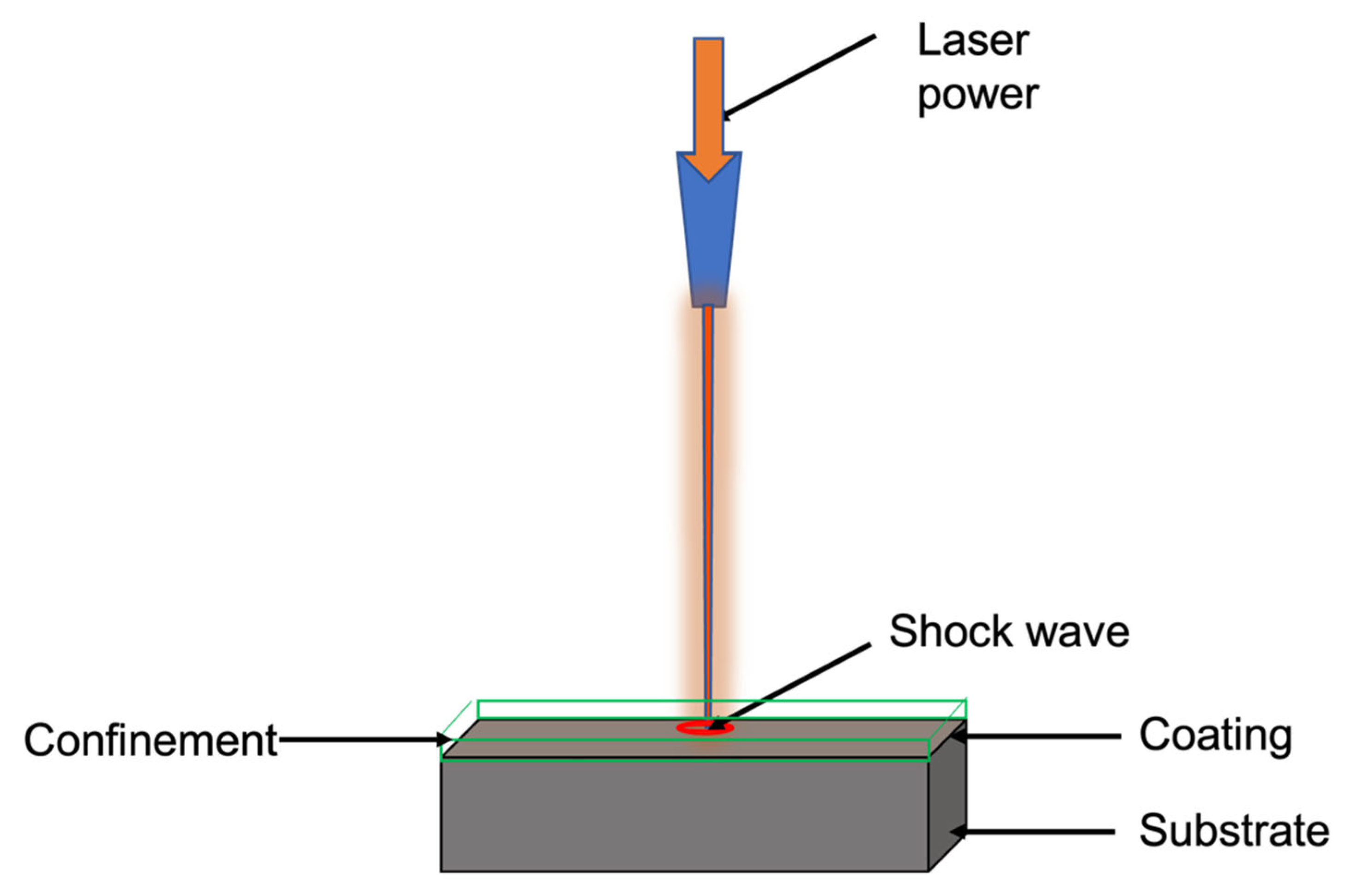
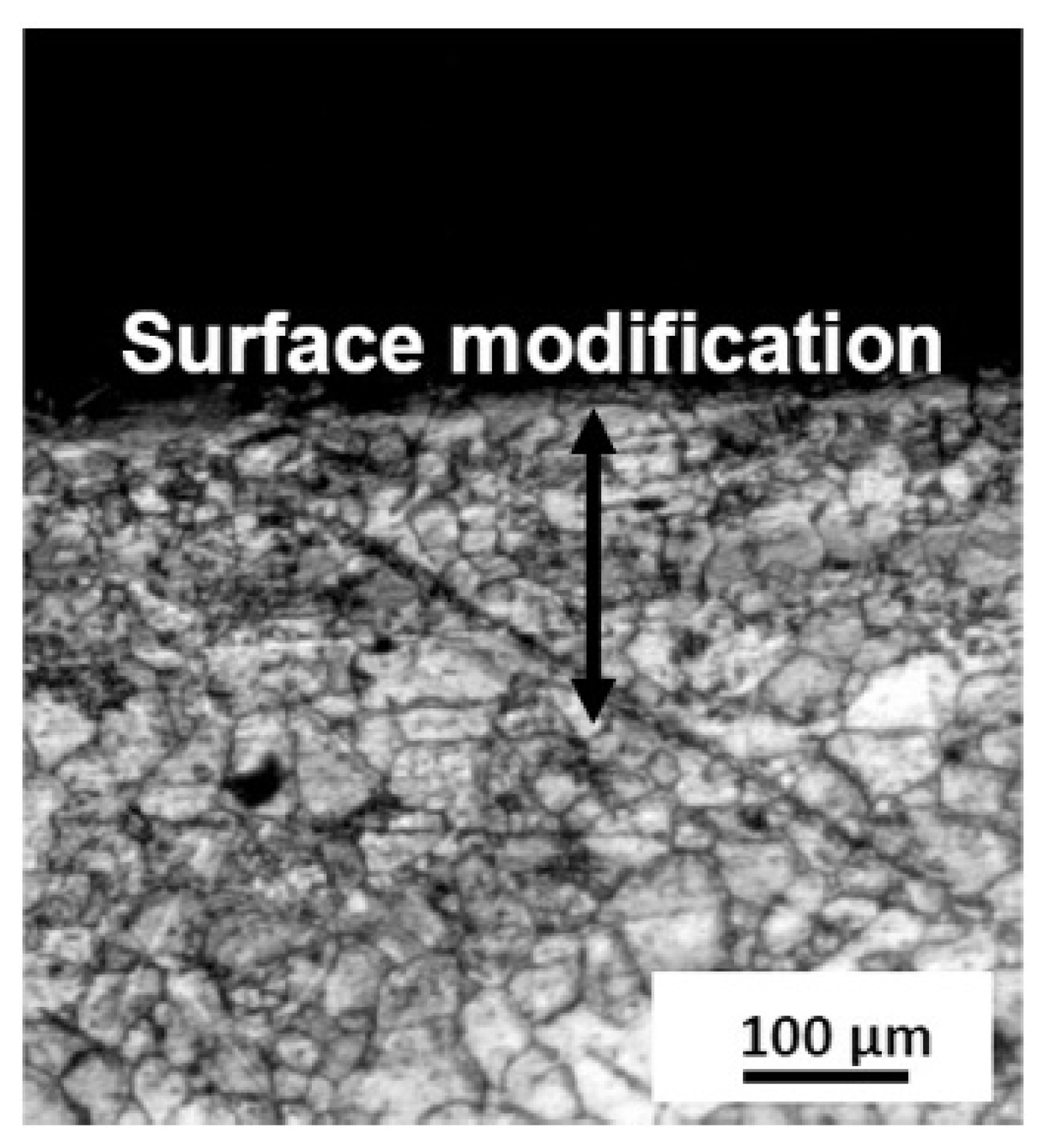

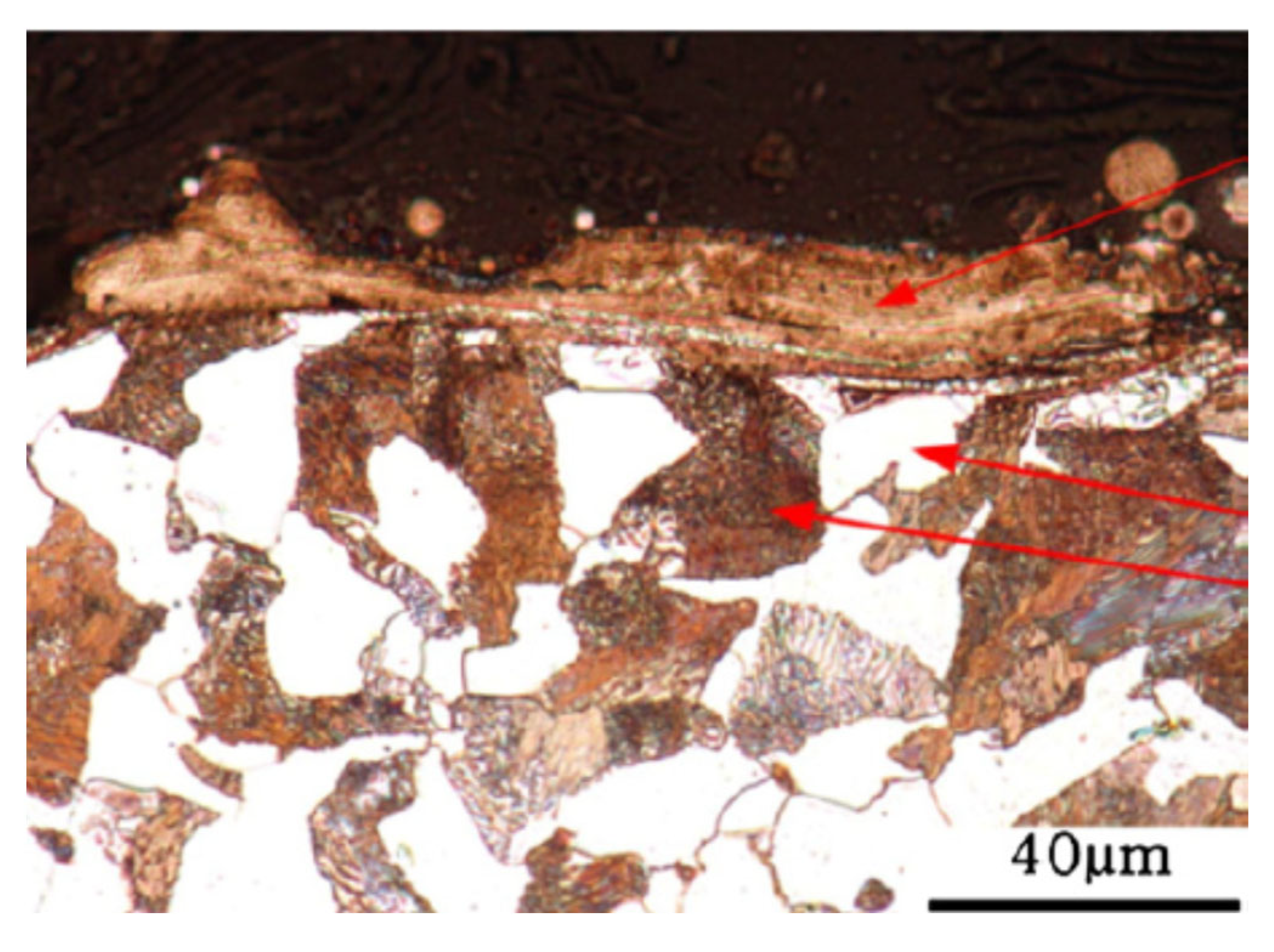
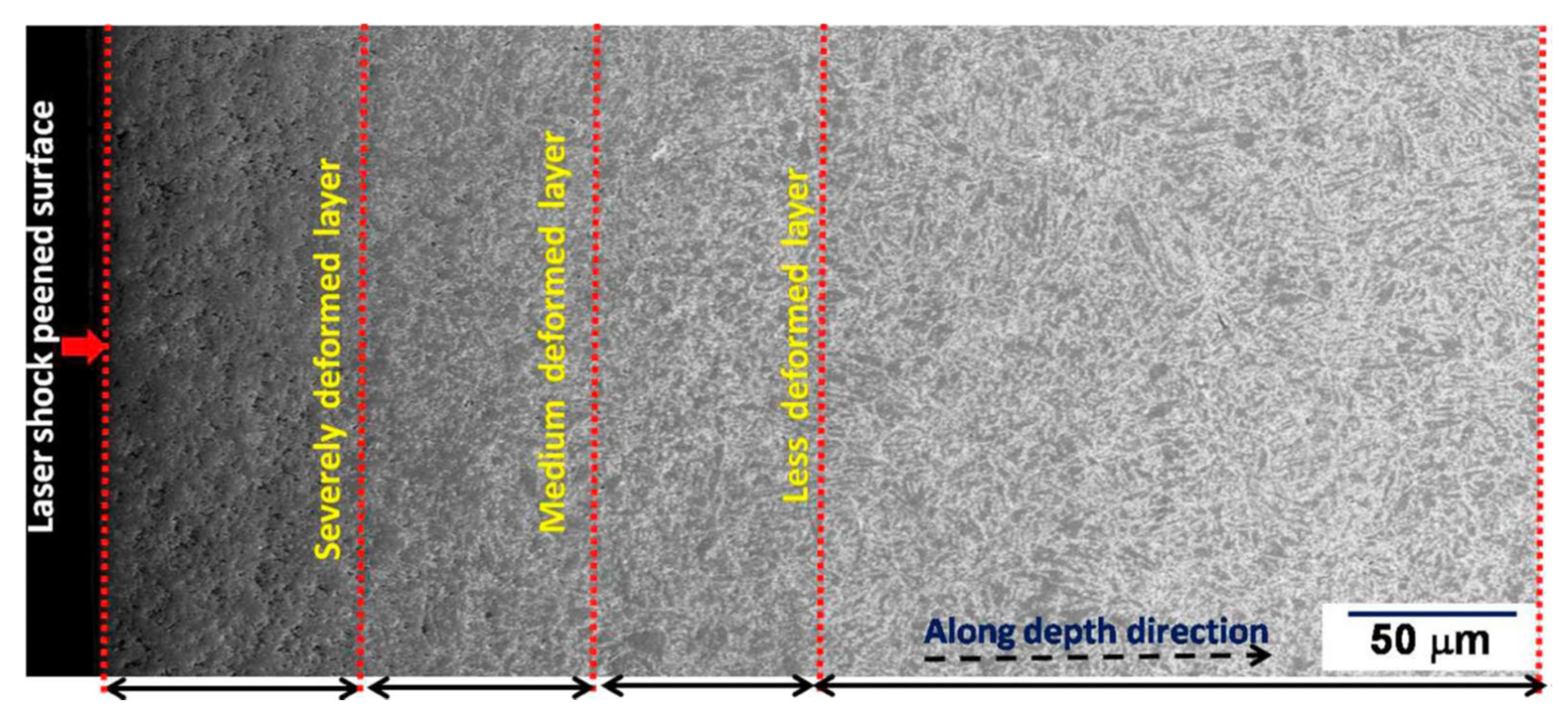

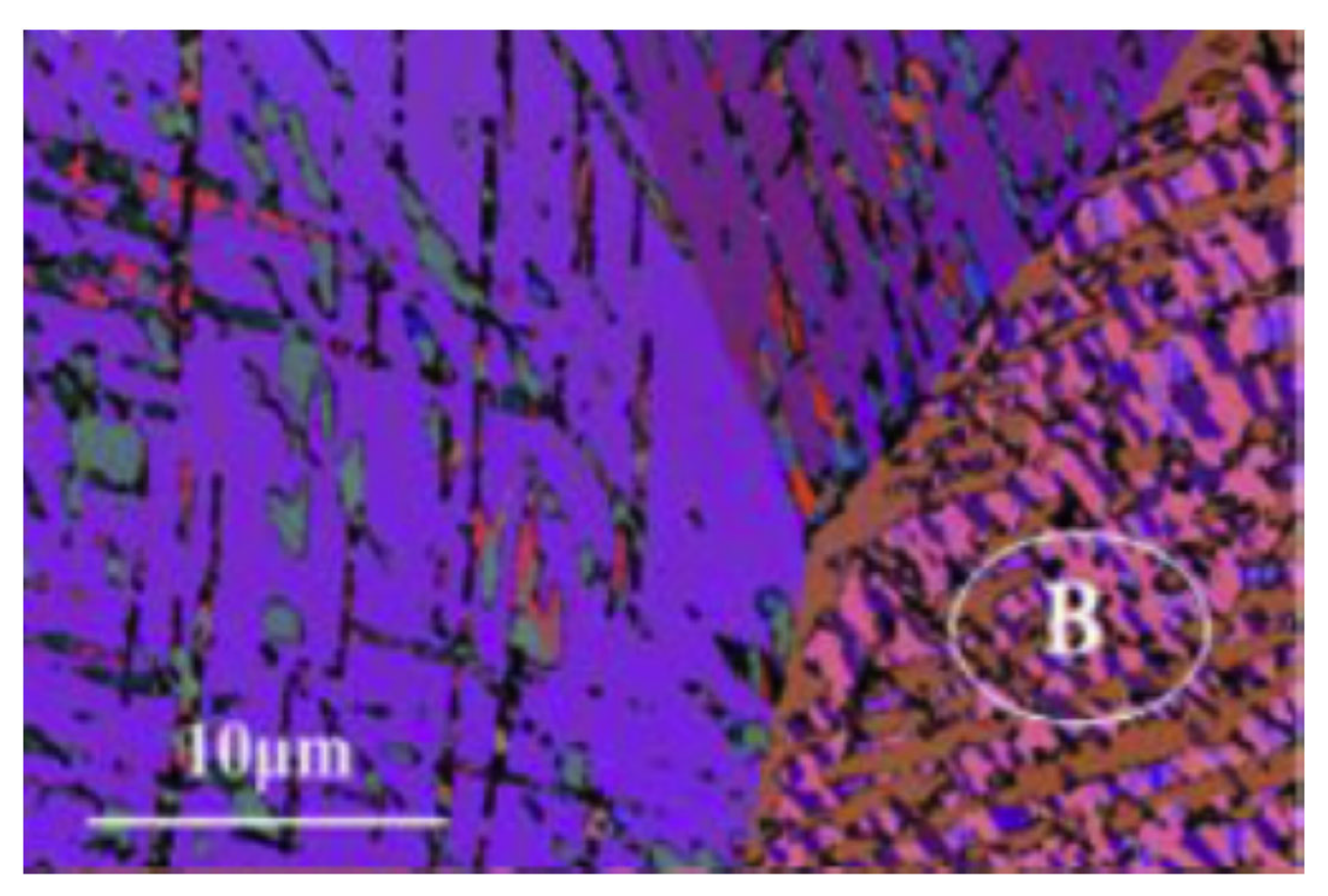
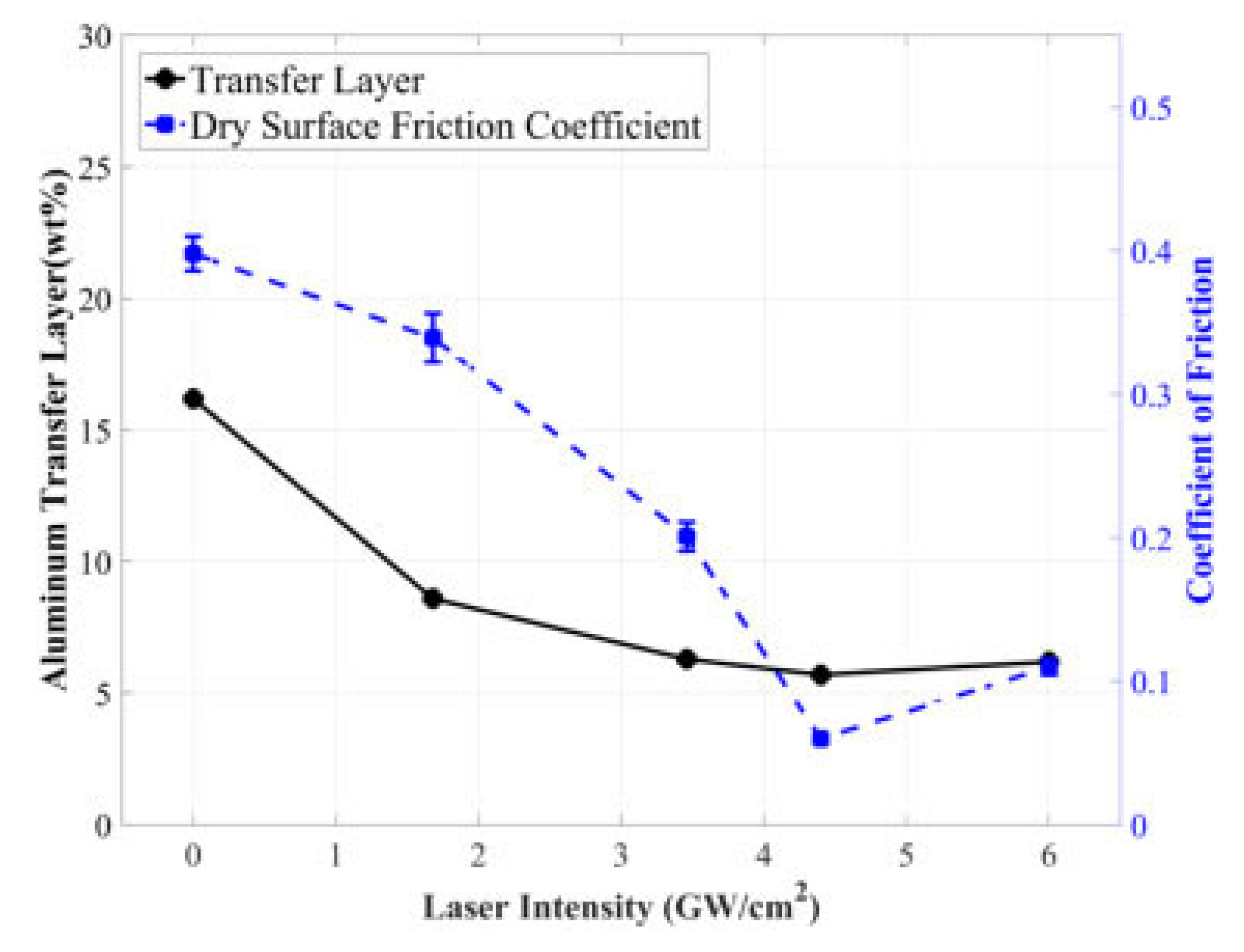
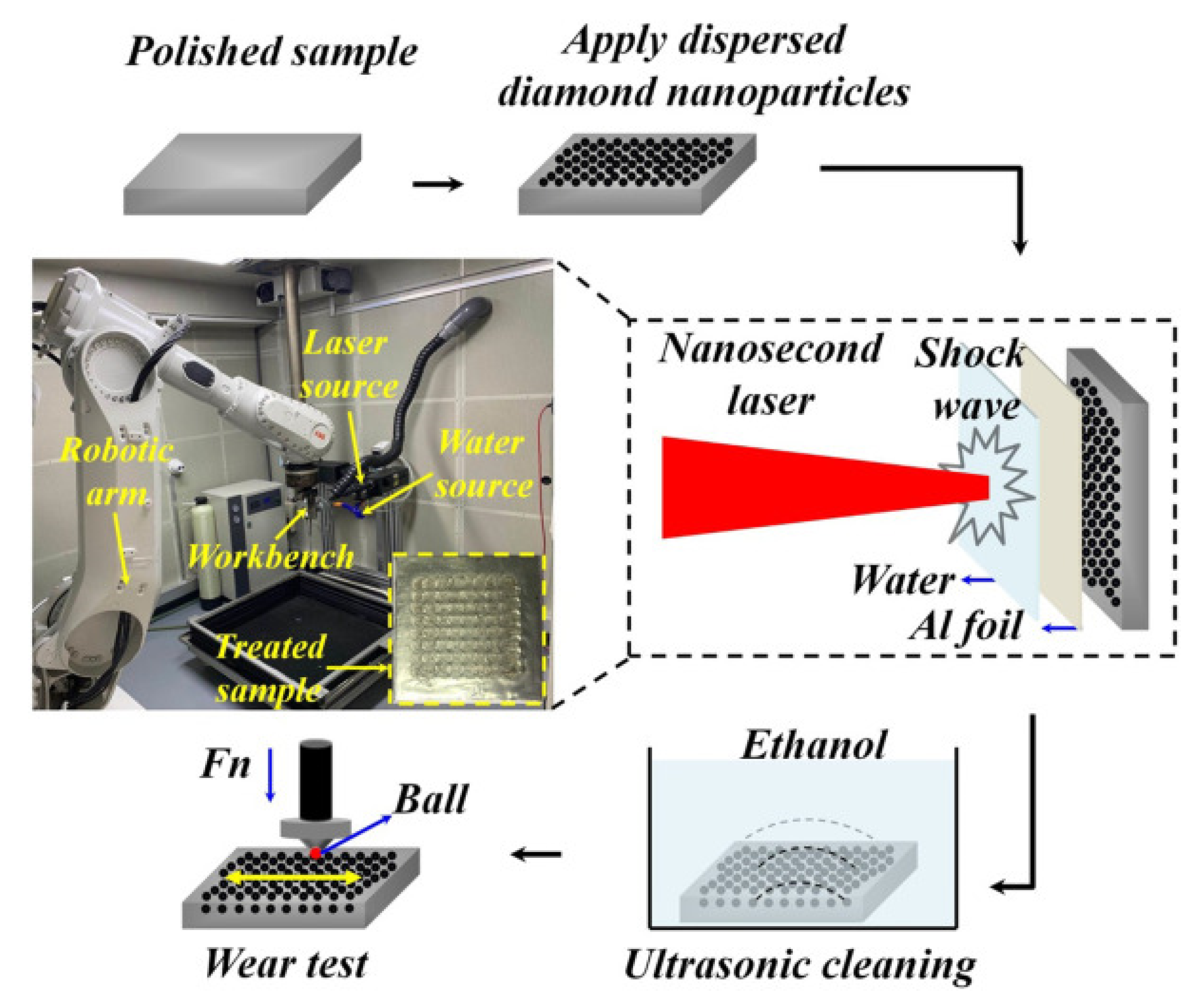
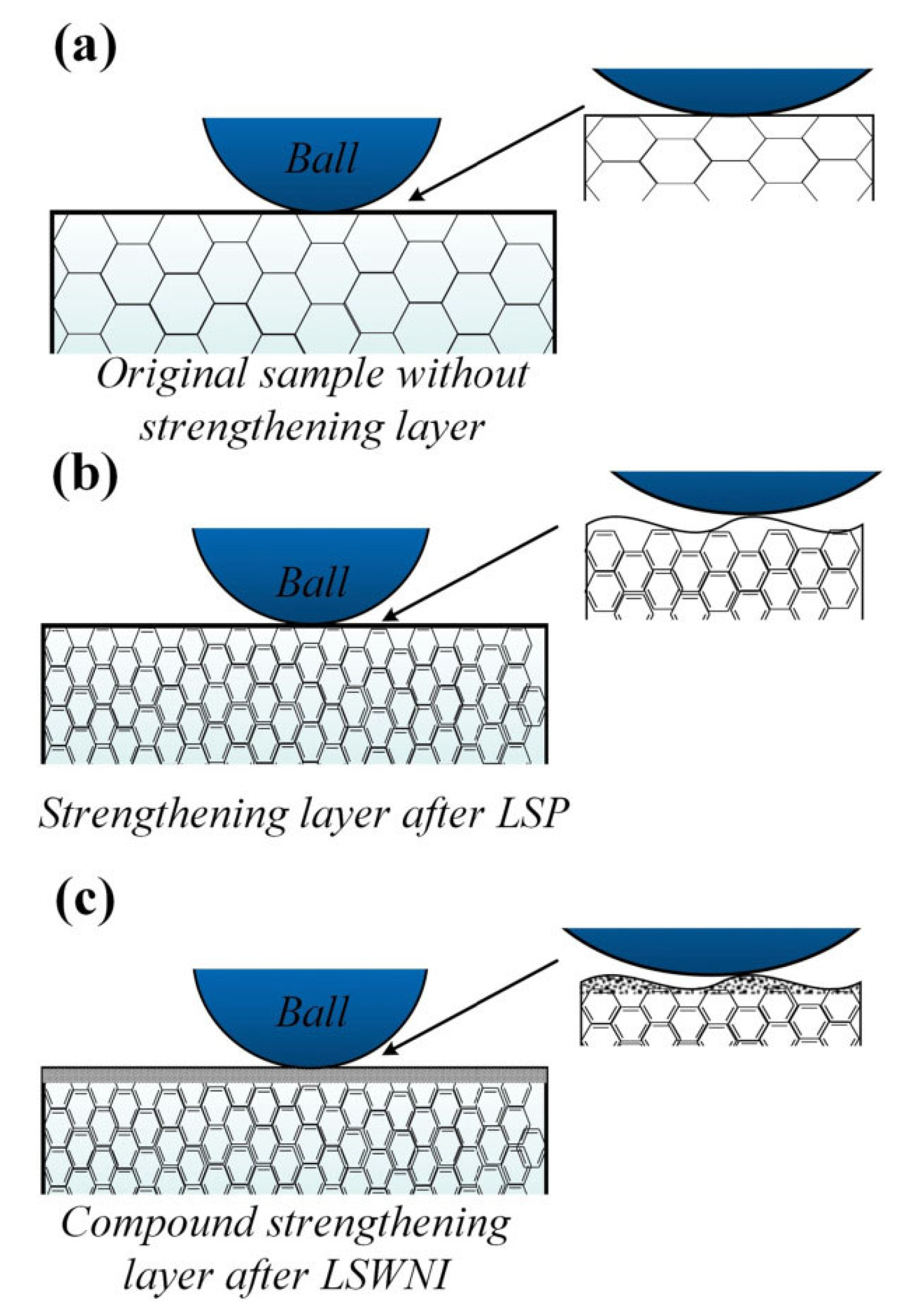
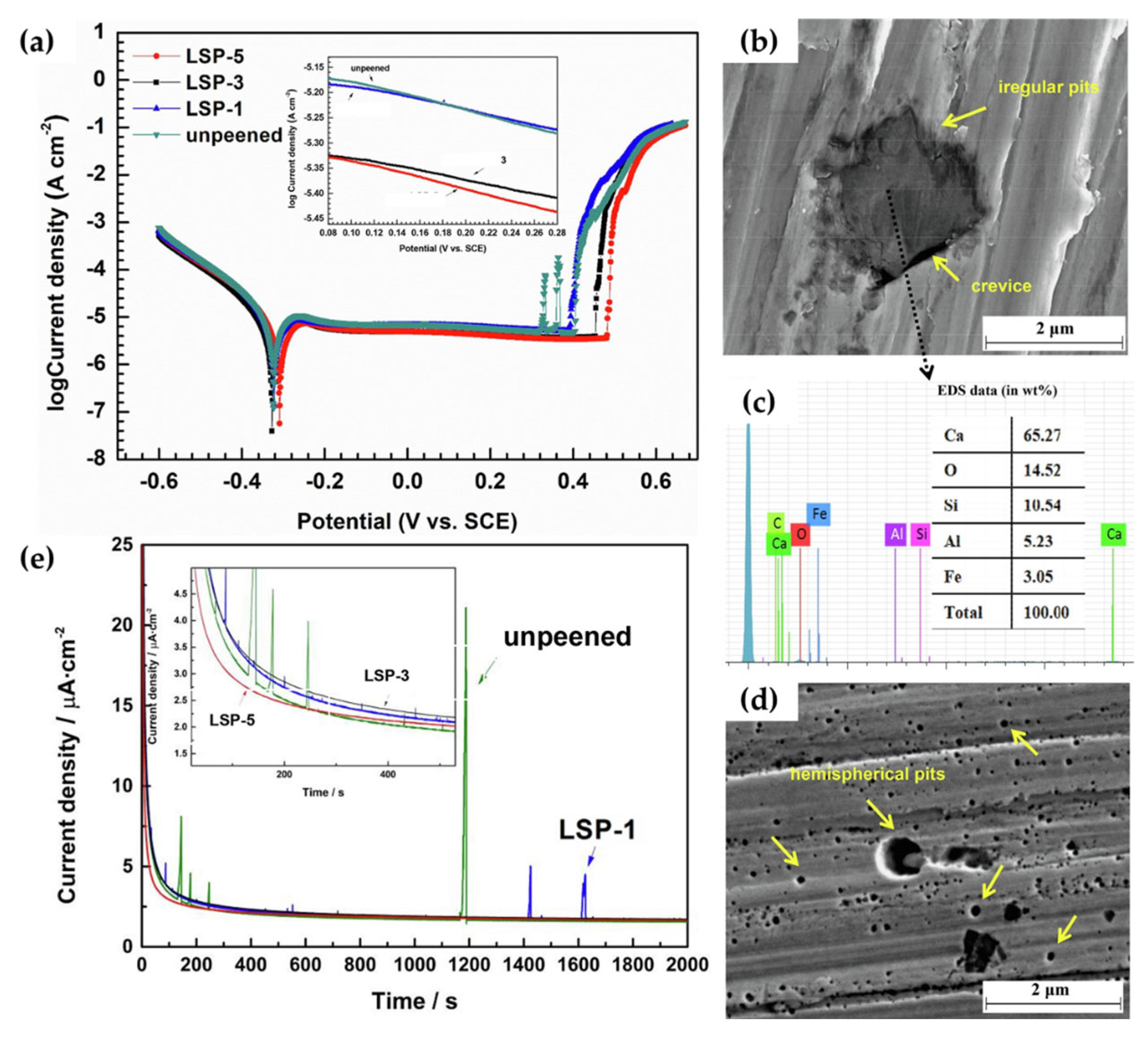
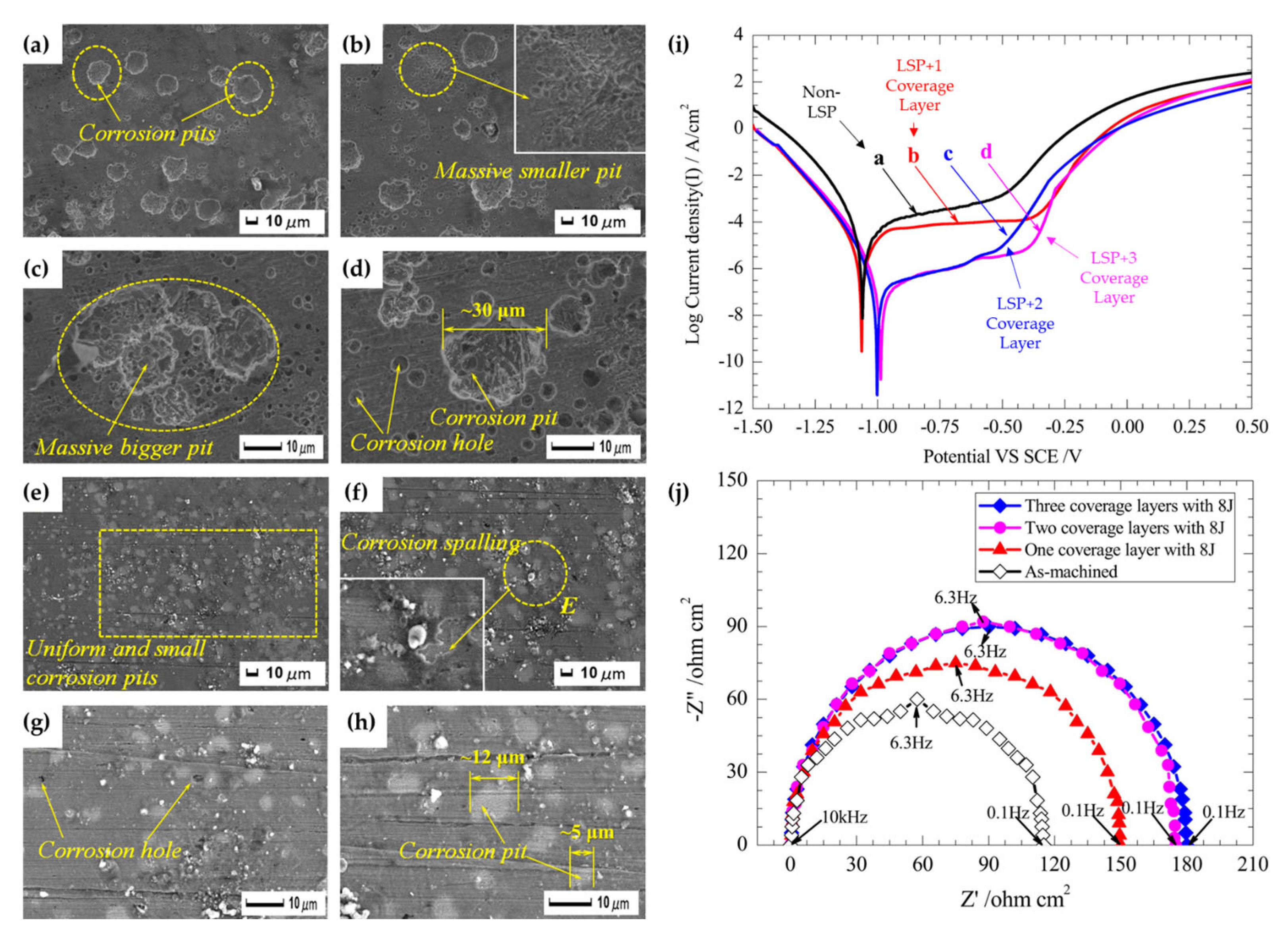
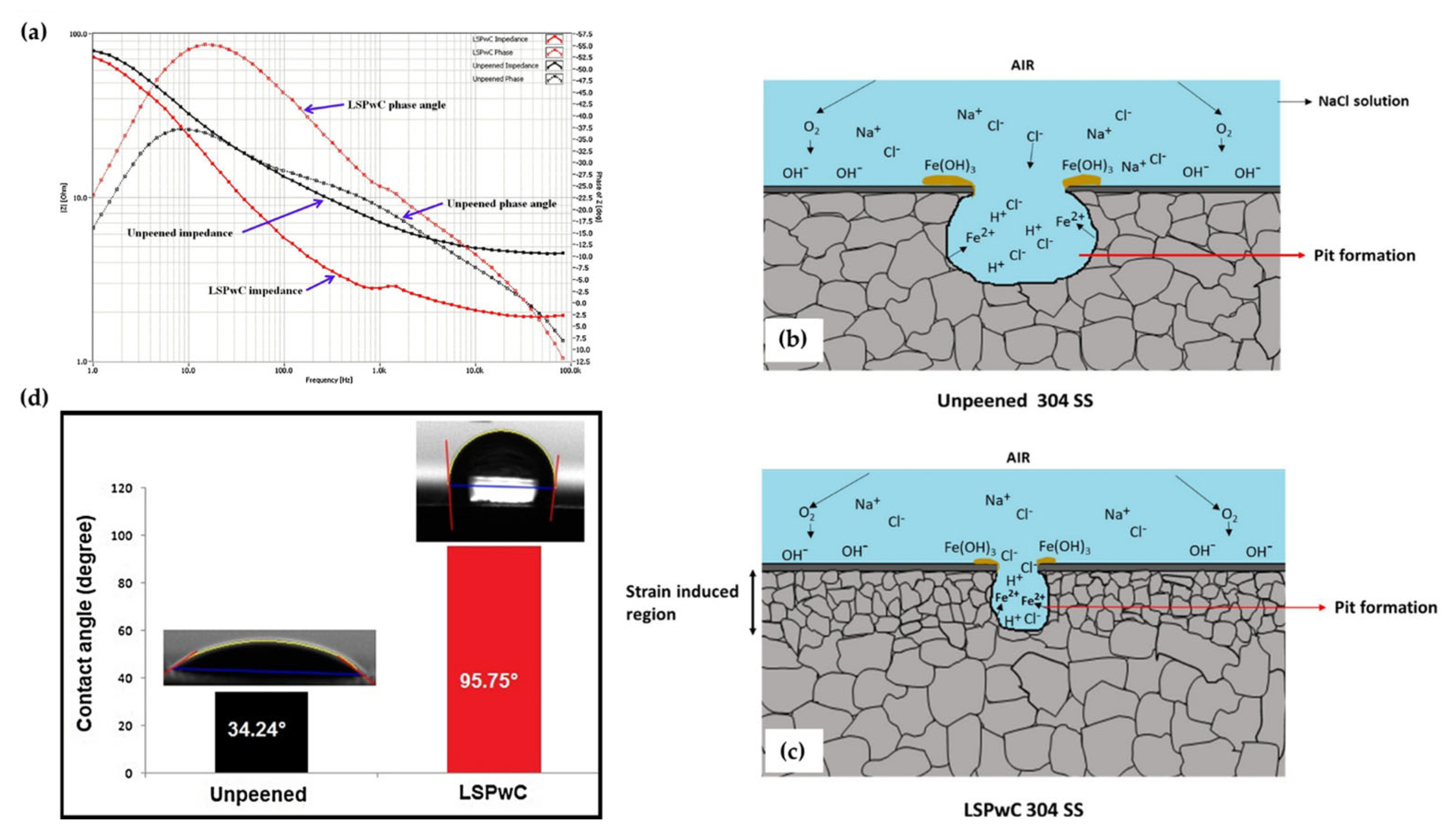

| Material | Testing Conditions | Findings | Reference |
|---|---|---|---|
| Interstitial free steel | Laser: Nd-YAG; pulse duration—7 ns; wavelength—1064 nm; size of impacts—5.6 mm; energy—170 mJ, 230 mJ, 290 mJ, and 340 mJ; spot size—5.6 mm; coverage rate—50%; processing time—5, 10, 15, and 20 min |
| [75] |
| Low carbon steel | Laser: Nd-glass phosphate; pulse duration—600 ps; wavelength—1054 nm; intensity—2.4 × 1012 W/cm2; spot size—3 mm; energy—120 J; coverage rate—25% |
| [76] |
| AISI 1045 steel | Laser: Nd-YAG; pulse duration—600 ps; wavelength—532 nm; intensity—2.4 × 1012 W/cm2; spot size—3 mm; energy—1.03 J; coverage rate—50%, 70%, and 90% |
| [77] |
| Ultrafine-grained high-carbon steel | Laser: Nd-glass phosphate; duration—10 ns; wavelength—1064 nm; repetition rate—Hz; spot size—3 mm; energy—2 J, 6 J; |
| [79] |
| Low-alloy steel | Laser: Nd-YAG; pulse duration—10 ns; wavelength—1064 nm; intensity—5.97 GW/cm2; repetition rate—10 Hz; spot size—0.8 mm; energy—300 mJ |
| [38] |
| 2r2Mn2Mo steel | Laser: Nd-YAG; pulse duration—10 ns; wavelength—1064 nm; spot size—3 mm; energy—5.43 J to 8.48 J; coverage rate—50% |
| [80] |
| P91 steel | Laser: Nd-YAG; pulse duration—10 ns; repetition rate—2 Hz; wavelength—1064 nm; spot size—3 mm; intensity—3.9 W/cm2, 4.7 W/cm2, and 5.5 W/cm2; coverage rate—57% |
| [81] |
| P91 steel | Laser: Nd-YAG; pulse duration—10 ns; repetition rate—2 Hz; wavelength—1064 nm; spot size—3 mm; intensity—3.9 W/cm2, 4.7 W/cm2, and 5.5 W/cm2; coverage rate—57% |
| [82] |
| AISI H13 Tool steel | Laser: fiber laser; pulse duration—20 µs; repetition rate—50 Hz; wavelength—1064 nm; spot size—80 µm; |
| [83] |
| SS 304 | Laser: Nd-YAG; pulse duration—17 ns; repetition rate—2 Hz; wavelength—1064 nm; spot size—1 mm; energy—125–300 µJ |
| [85] |
| SS 316 L | Laser: Nd-YAG; pulse duration—15 ns; repetition rate—2 Hz; wavelength—1064 nm; spot size—3 mm; energy—9 J; coverage rate—57% |
| [91] |
| Material | Testing Conditions | Findings | Reference |
|---|---|---|---|
| 100Cr6 rolling steel | Laser: CLFA-LALP; pulse duration—10 ns; wavelength—1064 nm; size of impacts—5.6 mm; energy—22 mJ; spot size—7 mm; coverage rate—25% Tribology: counter roller of steel 40CrMoV13; room temperature; dry sliding speed—0.0673 m/s; roll-slide ratio—50; load—20.2 N to 153 N; pressure—72 MPa to 200 MPa |
| [65] |
| 20Cr2Mn2Mo steel | Laser: Nd-YAG; pulse duration—10 ns; wavelength—1064 nm; energy—4 J, 6 J, and 8 J; spot size—3 mm; coverage rate—50%; number of impacts—1, 2, and 3 Tribology: room temperature; dry sliding speed—5 mm/s; roll-slide ratio—50%; load—30 N |
| [80] |
| 1045 steel | Laser: Nd-YAG; pulse duration—5 ns; wavelength—1064 nm; intensity—1.68 GW/cm2, 3.46 GW/cm2, 4.40 GW/cm2, and 6 GW/cm2; spot size—1.5 mm; coverage rate—50% Tribology: Rtec multifunctional tribometer; dry; room temperature; sliding speed—2 mm/s; sliding distance—10 mm; load—50 N; humidity—30% |
| [73] |
| AISI 304 | Laser: Nd-YAG; pulse duration—5 ns; wavelength—1064 nm; intensity—9 GW/cm2; spot size—0.8 mm; coverage rate—70%; energy—450 mJ; peening passes—1 and 5; fretting—DUCOM; ball on plate; counter—alumina; dry; load—5 N, 10 N, and 20 N; room temperature; sliding speed—2 mm/s; sliding amplitude—100 µm; frequency—5 Hz; number of cycles—18,000 |
| [108] |
| 20Cr2Ni4A | Laser: YS100-R200A; pulse duration—20 ns; wavelength—1064 nm; intensity—0 J, 4 J, 6 J, 8 J, and 10 J; spot size—3 mm; coverage rate—50%; repetition rate—10 Hz Tribology: UMT-2 multifunctional tribometer; counter—440 carbon steel; dry; room temperature; sliding speed—5 mm/s; sliding distance—6 mm; load—30 N |
| [102] |
| A304 SS | Laser: Q-switched rubidium glass laser; pulse duration—10 ns; wavelength—1064 nm; intensity—12 J; spot size—7 mm; coverage rate—30%; repetition rate—5 Hz Tribology: UMT-2 multifunctional tribometer; counter—440 carbon steel; dry; room temperature; sliding speed—275 r/min and 450 r/min; sliding distance—6 mm; load—1 N, 2 N, and 5 N |
| [106] |
| Duplex stainless steel | Laser: Nd-YAG; pulse duration—8 ns; wavelength—532 nm; intensity—10 GW/cm2; spot size—11 mm; coverage rate—30%; repetition rate—10 Hz Tribology: UMT-2 multifunctional tribometer; counter—SKD 61; dry; room temperature; sliding speed—160 RPM; load—3 kg, 6 kg, and 10 kg |
| [33] |
| Material | Testing Conditions | Observations | Reference |
|---|---|---|---|
| Duplex SS | Laser: Nd-YAG; pulse duration—8 ns; wavelength—532 nm; intensity—10 GW/cm2; spot size—11 mm; coverage rat—30%; repetition rate—10 Hz Corrosion: PDP in 3.5 wt.% NaCl for 120 min and nitrogen injection at 200 mL/min to purge oxygen; carbon rod and saturate calomel electrode Applied potential: −400 mV to 1000 mV |
| [33] |
| Martensitic steels | Laser: YS120-R200A; pulse duration—16 ns; wavelength—1064 nm; energy—7.6 J; spot size—3 mm; coverage rate—50%; repetition rate—2 Hz Corrosion: PDP in 3.5 wt.% NaCl for Scanning rate: 1 mV/s and potential range −0.2 V to 0.2 V EIS at different times 1 day–30 days; 5 mV sinusoidal perturbation from 100 KHz to 0.01 Hz |
| [117] |
| SS 316 L weld joint | Laser: Nd-YAG; pulse duration—15 ns; wavelength—1064 nm; energy—9 J; spot size—3 mm; coverage rate—50% Corrosion: PDP in 3.5 wt.% NaCl for Scanning rate: 5 mV/s and potential range −2 V to 2 V |
| [91] |
| SS 304 L | Laser: Nd-YAG; pulse duration—15 ns; wavelength—1064 nm; intensity—3.18 GW/cm2 to 15.925 GW/cm2; energy—9 J; spot size—3 mm; coverage rate—50%; repetition rate—10 Hz Corrosion: slow strain rate test in 3.5 wt.% NaCl. The SCC sensitivity index is used to evaluate localized corrosion resistance |
| [118] |
| AISI 304 L | Laser: Nd-YAG; pulse duration—15 ns; wavelength—1064 nm; energy—30 J; spot size—3 mm; coverage rate—50 %; repetition rate—1 Hz Corrosion: slow strain rate test in 5 wt.% NaCl + 0.6 mol sulfuric acid |
| [119] |
| ANSI 316 L SS | Laser: Nd-YAG; pulse duration—5 ns; wavelength—1064 nm; energy—0.32–0.058 J; spot size—7 mm; coverage rate—50%; repetition rate—1–10 Hz Corrosion: potential range—−0.25 to +0.25 V; step height—1 mV; scan rate—1 or 10 mV/S; initial open-circuit delay OCP—60 s Nyquist; initial OCP—1000 s frequency range—10 mHz–10 kHz |
| [51] |
| 300 M steel | Laser: Nd-YAG; pulse duration—20 ns; wavelength—1064 nm; energy—3 J and 7 J; spot size—3 mm; coverage rate—50%; repetition rate—3 Hz; Corrosion: 3.5 wt.% NaCl; pull axial loading; stress ratio—0.1; maximum axial stress—400 MPa–800 MPa |
| [120] |
| SS 304 L | Laser: Nd-YAG; pulse duration—20 ns; wavelength—1064 nm; intensity—6.4 GW/cm2; spot size—2 mm; coverage rate—10%; repetition rate—3 Hz; impacts—1, 3, and 5 Corrosion: Potentiodynamic and potentiostatic polarization studies were performed at room temperature in a 3.5 wt% NaCl |
| [111] |
| SS 316 L | Laser: Nd-YAG; pulse duration—20 ns; wavelength—1064 nm; intensity—5.52 GW/cm2; spot size—2.4 mm; coverage rate—10%; repetition rate—1 Hz; impacts—1, 2, and 3 Corrosion: electrochemical corrosion; exposed area 1 cm2; at room temperature in a 3.5 wt% NaCl; salt spray corrosion test—22.3 NaCl solution |
| [121] |
Disclaimer/Publisher’s Note: The statements, opinions and data contained in all publications are solely those of the individual author(s) and contributor(s) and not of MDPI and/or the editor(s). MDPI and/or the editor(s) disclaim responsibility for any injury to people or property resulting from any ideas, methods, instructions or products referred to in the content. |
© 2023 by the authors. Licensee MDPI, Basel, Switzerland. This article is an open access article distributed under the terms and conditions of the Creative Commons Attribution (CC BY) license (https://creativecommons.org/licenses/by/4.0/).
Share and Cite
John, M.; Ralls, A.M.; Kuruveri, U.B.; Menezes, P.L. Tribological, Corrosion, and Microstructural Features of Laser-Shock-Peened Steels. Metals 2023, 13, 397. https://doi.org/10.3390/met13020397
John M, Ralls AM, Kuruveri UB, Menezes PL. Tribological, Corrosion, and Microstructural Features of Laser-Shock-Peened Steels. Metals. 2023; 13(2):397. https://doi.org/10.3390/met13020397
Chicago/Turabian StyleJohn, Merbin, Alessandro M. Ralls, Udaya Bhat Kuruveri, and Pradeep L. Menezes. 2023. "Tribological, Corrosion, and Microstructural Features of Laser-Shock-Peened Steels" Metals 13, no. 2: 397. https://doi.org/10.3390/met13020397
APA StyleJohn, M., Ralls, A. M., Kuruveri, U. B., & Menezes, P. L. (2023). Tribological, Corrosion, and Microstructural Features of Laser-Shock-Peened Steels. Metals, 13(2), 397. https://doi.org/10.3390/met13020397







